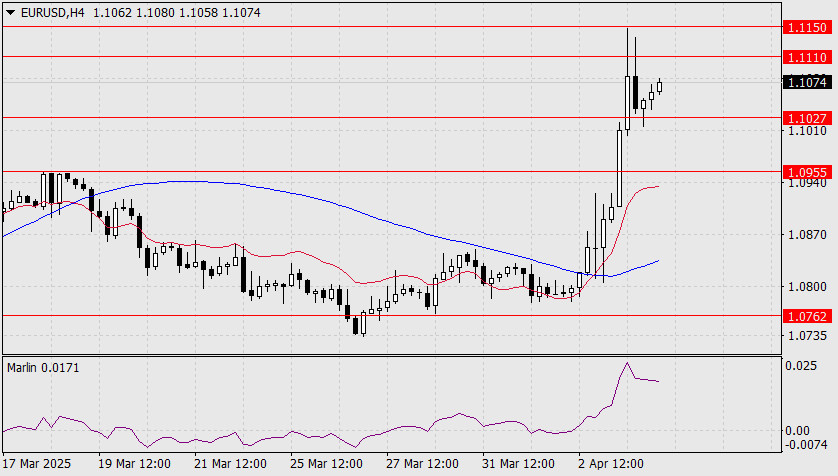On Thursday, investors flight from risk, and the dollar reached its peak: the S&P 500 dropped by 4.84%, the dollar index by 1.64%, oil by 6.90%, gold by 1.00%, copper by 4.38%, and bitcoin by 3.85%. It’s worth noting that these instruments have reached their technical targets and now appear visually ready for a correction. So, could the panic be over? Even the peak of the Brexit panic in June 2016 lasted just two days, excluding weekends; the pound lost 16.5 figures in two sessions, rebounded by three figures over the next two days, followed by a prolonged, wide-ranging consolidation until the end of August.
The approaching crisis does not seem to frighten the U.S. government. There is a remarkable word in the perestroika vocabulary that Trump, given his age, surely knows. The essence of the current “rebalancing of distortions” lies in economic revitalization. The last time we saw a process like this was during the historic 2008 crisis, when the market purged itself of the default swap pyramid and other “parasites on the body of capitalism,” simultaneously boosting the real economy.
Trump’s version of revitalization began with a large-scale reorganization of budgetary institutions, which had grown during the pandemic. One hundred fifty thousand employees across various agencies have been or will be laid off. The February Nonfarm Payrolls report showed a gain of 150,000 compared to 125,000 in January, and the forecast for March (to be published today) is 137,000 — also a solid figure. However, the key indicator of the current labor market situation is the total number of people receiving unemployment benefits, and this figure, published yesterday, is at 1.903 million — the same level as in February of last year. Nothing alarming has occurred — those laid off are finding new employment. We expect optimistic U.S. labor market data release today and a general correction across markets.
Our target range of 1.1110–1.1150 on the daily chart has been met. A correction toward 1.0955 is possible, and if the market still has an appetite for further growth (a breakout above 1.1150), the next target could be 1.1276. We need technical confirmation that the market is cooling off, and today’s data could significantly influence this.
It is also worth noting that over the past three days, the yield on 5-year U.S. Treasury bonds has declined from 3.91% to 3.70% (a level last seen in September 2024), a factor supporting the dollar.

The price has begun consolidating within the range of 1.1027–1.1110 on the four-hour chart, while the Marlin oscillator is exiting overbought territory. We await the data release and the euro’s reaction.
The material has been provided by InstaForex Company – www.instaforex.comOn Thursday, investors flight from risk, and the dollar reached its peak: the S&P 500 dropped by 4.84%, the dollar index by 1.64%, oil by 6.90%, gold by 1.00%, copper by 4.38%, and bitcoin by 3.85%. It’s worth noting that these instruments have reached their technical targets and now appear visually ready for a correction. So, could the panic be over? Even the peak of the Brexit panic in June 2016 lasted just two days, excluding weekends; the pound lost 16.5 figures in two sessions, rebounded by three figures over the next two days, followed by a prolonged, wide-ranging consolidation until the end of August.The approaching crisis does not seem to frighten the U.S. government. There is a remarkable word in the perestroika vocabulary that Trump, given his age, surely knows. The essence of the current “rebalancing of distortions” lies in economic revitalization. The last time we saw a process like this was during the historic 2008 crisis, when the market purged itself of the default swap pyramid and other “parasites on the body of capitalism,” simultaneously boosting the real economy.Trump’s version of revitalization began with a large-scale reorganization of budgetary institutions, which had grown during the pandemic. One hundred fifty thousand employees across various agencies have been or will be laid off. The February Nonfarm Payrolls report showed a gain of 150,000 compared to 125,000 in January, and the forecast for March (to be published today) is 137,000 — also a solid figure. However, the key indicator of the current labor market situation is the total number of people receiving unemployment benefits, and this figure, published yesterday, is at 1.903 million — the same level as in February of last year. Nothing alarming has occurred — those laid off are finding new employment. We expect optimistic U.S. labor market data release today and a general correction across markets.Our target range of 1.1110–1.1150 on the daily chart has been met. A correction toward 1.0955 is possible, and if the market still has an appetite for further growth (a breakout above 1.1150), the next target could be 1.1276. We need technical confirmation that the market is cooling off, and today’s data could significantly influence this.It is also worth noting that over the past three days, the yield on 5-year U.S. Treasury bonds has declined from 3.91% to 3.70% (a level last seen in September 2024), a factor supporting the dollar.The price has begun consolidating within the range of 1.1027–1.1110 on the four-hour chart, while the Marlin oscillator is exiting overbought territory. We await the data release and the euro’s reaction.The material has been provided by InstaForex Company – www.instaforex.com Read More
Forex analysis review






